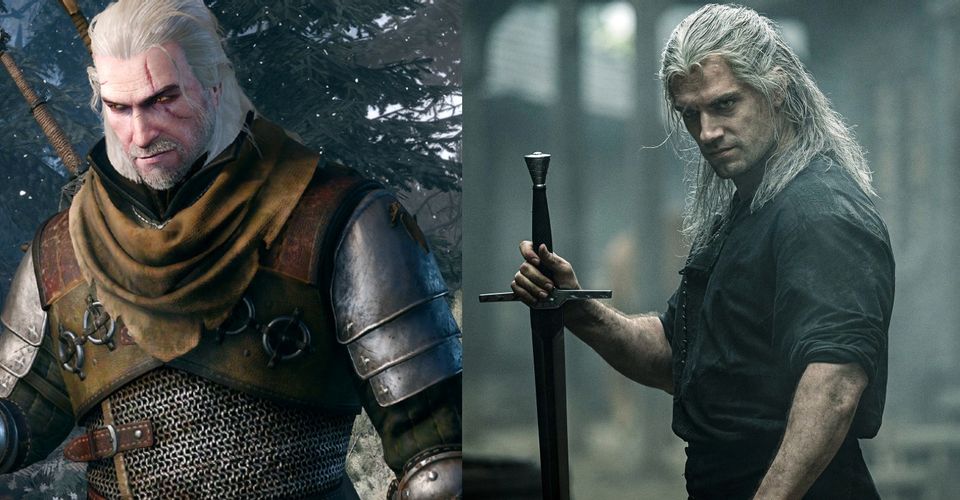Witcher 3 Characters Completely Different From The Books & Show

Netflix’s The Witcher introduced many key characters from the Witcher 3: Wild Hunt game, based on the popular fantasy novel series by Polish author Andrzej Sapkowski, but all three versions of these characters can vary dramatically. The popular open-world RPG, Witcher 3: Wild Hunt, is set in the fantasy world of the Continent and follows the story of protagonist Geralt, a monster slayer for hire with supernatural and magical abilities, due to genetic mutations from training and experimentation in early childhood.
[Warning: Spoilers for The Witcher Season 2 are below.]
The story follows Geralt on his travels, as he utilizes magic and alchemy in the Witcher games, books, and show, as well as typical sword combat techniques to help navigate his way in the treacherous Continent. Geralt interacts with countless friends, foes, and monsters which feature to varying degrees in all adaptations of the source material. Sapkowski’s six-novel series, accompanied by a multitude of short stories, was initially adapted into the three-game series culminating in the much loved Witcher 3, the events of which take place in the Continent calendar year 1272.
However, the Netflix adaptation’s timeline is infamously confusing, covering events from as early as Geralt’s travels in 1231 to the fall of Cintra in 1263, with Season 2’s linear timeline directly continuing from the Battle of Sodden Hill and Geralt and Ciri’s destined meeting in 1263. Despite having varying timelines, crossovers do occur between characters from the game and the show, which often differ from both the book material and each other, especially in relation to characters.
Netflix’s Adaptation Did Witcher 3’s Eskel Dirty

Fans have been in an uproar over Netflix’s portrayal of Eskel that deviates from both Witcher 3 and the books in recently released Season 2. In Episode 2, the show follows Geralt and Ciri as they arrive at the Witcher stronghold, Kaer Morhen, and meet familiar Witcher 3 characters including Vesemir, Lambert, and Coen. However, it was Eskel’s arrival (and swift departure) that has left fans frustrated and upset at Season 2’s deviations from the source material. In Witcher 3 and the books, Eskel serves as a mirror for Geralt’s character, having trained as a Witcher at the same time and having his own Child of Surprise. He is a remarkably honorable person who operates with a kind, relaxed personality despite his tough, scarred exterior, acting as a loyal friend and ally to Geralt throughout the games and books.
However, the Netflix show introduced Eskel as quite the opposite. While it was clear Geralt and Eskel share a strong bond as they immediately embrace, Eskel’s character quickly deviates from the books and games as he throws a lewd party at the fortress, despite Geralt’s disapproval. Eskel’s partaking in this behavior at Kaer Morhen seems unlike him, as in the first book Blood of Elves, Eskel respectfully bowed and kissed the hand of enchantress Triss within the same halls.
Though Netflix’s Eskel has a facial scar true to Witcher 3, he is impudent, brash, and even intimidates Ciri. Book Ciri’s initial impressions of Eskel include that he’s smelly and scary, but this is quickly reconciled as the two talk it out. Perhaps it is due to Eskel’s leshy affliction that he is acting so out of character, but this deviation from the source material seems unnecessary, as there are other minor characters, though no female Witchers, that could have fulfilled that plot.
Witcher 3’s Triss Plays A Larger Role Than In The Show & Books

Enchantress Triss Merigold features as a major character in all three of the Witcher games, being one of the first people Geralt meets and swiftly becoming his lover, though she takes a romantic backseat in Witcher 3 due to the introduction of Yennefer of Vengerberg. Triss in all three franchises is an extremely gifted healer specializing in the use of magical potions, despite being ironically allergic to them herself. Despite coupling with the Witcher in the books, Triss is unhappily in unrequited love with Geralt in both the books and the games; the show touches on their evidently strong connection, though this is not explored. Netflix’s Triss looks different in Season 2 compared to Season 1, as her hair appears a brighter red color – linking closer to her book and game appearances.
However, Triss’ prominent position in the games is a disruption to the lore of the source material. In the books (and the show), Triss does not have this much spotlight. In Blood of Elves, Triss helps to train Ciri at Kaer Morhen, protecting her from being subject to harmful genetic mutations and acting like an older sister to the princess. Triss’ feature in the show alongside Geralt is relatively short compared to her friend Yennefer, and in Season 2 she plays the important role of Ciri’s mentor before the princess is revealed to be a Child of Elder Blood. Overall, while Triss’ powers as a mage are accurate throughout the books, games, and show, Triss’ relationship with Geralt is much exaggerated in The Witcher 3 compared to the source material, which the show seems to be truer to.
The Bard Is Far More Famous In The Books Than Netflix’s Jaskier or Witcher 3’s Dandelion

The bard is a prominent character in all three versions of The Witcher material, serving as a companion to Geralt and singing of their adventures. Yet, differences occur immediately with his name. In Witcher 3, the bard is called Dandelion, a name that is shared with the English translations of Sapkowski’s books. However, Netflix changed Dandelion’s name from the books and instead took the original name for the character – Jaskier – which translates from Polish to buttercup.
Despite his flowery name, all three versions of the bard vary quite substantially. Witcher 3’s Dandelion is always wearing extremely bright, colorful clothes and often a feathered hat, and his wardrobe makes him stand out from the crowd quite substantially. This aspect is not shared by the books or the show, though in the latter he may wear slightly more color than other characters.
Netflix’s Geralt is extremely unfriendly to Jaskier, who is meant to be Geralt’s best friend and travel companion. While the two do have spats in the books, the relationship portrayed in the games and show seems too harsh, with the bard appearing as a burden to the Witcher. Book Dandelion is a gifted talker and flirt, a talented singer, and a dear companion to Geralt, while his show and game counterparts seem a little lackluster, other than his outfits in the latter. The largest variation occurs in the bard’s fame; in the books, Dandelion is a world-renowned singer and writer, detailing Geralt’s many adventures in song and writing. However, both Netflix’s Jaskier and Witcher 3’s Dandelion do not have the same fame or money, and they do not sing nearly as frequently as Dandelion does in the books, regardless of the famous “Toss A Coin To Your Witcher” song.
Witcher 3’s and Netflix’s Geralt & Ciri Are Different To The Books, Not Just In Age

While Netflix’s Geralt is largely reminiscent of the game protagonist in his grunts and stoic nature, likely as Henry Cavill has played The Witcher 3, differences lie between Book Geralt and these two iterations, particularly in relation to his brooding, thoughtful characterization in the novels. Book Geralt often acts like a grumpy mutant and is sometimes ignorant and uncaring, but he is still shown to be a sensitive person. This thoughtful side is mostly shown when he is with Ciri and Yennefer, his adoptive family, and can even extend to monsters, shown in Witcher 3 as he converses with the Rock Trolls instead of killing them instantly.
Perhaps due to limitations of the medium, the show does not always convey this side to Geralt’s character as easily as the books or games, with allow for exploration through inner monologue. A surprising deviation occurs in that Book Geralt is not quite Henry Cavill, and is in fact described as “ugly” and “skinny,” possessing an “unpleasant voice“. This is not a deviation one would expect from the familiar white-haired protagonist of the Witcher games.
Witcher 3 is set roughly 10 years after Netflix’s Season 2, so naturally, there is a discrepancy in Ciri’s age between Witcher 3 and the show. In the game, Ciri is a confident young woman and warrior, coming to terms with her immense supernatural power, while the show depicts a younger Ciri on her journey of self-discovery and initial training. Her apparent age is inaccurate to the book, however, within which Ciri is a lot younger. In fact, she is so small in the early books that Geralt often carries her on his shoulders. Netflix wisely aged up Ciri from the source material, and both the show and game portray a watered-down version of her character and history. In the books, Ciri survives through endless abuse and people wanting her for her power, and she becomes a little unhinged, at one point joining a group of bandits and murdering innocent people. It is unclear whether Netflix will follow this path with Ciri’s character, but developers CD Projekt Red definitely made Ciri a more digestible and relatable character by omitting her turbulent past.
Of course, deviations from The Witcher books have had to occur when adapting the source material into both the games and the show. Overall, The Witcher games, books, and show all share similarities in the Continent’s mythos and geopolitics, though big changes do occur when rewriting character appearance, personality, and history for different media. Regardless of changes, author Sapkowski seems to be at peace with the adapted materials, noting Witcher 3: Wild Hunt‘s function as an “adaptation containing elements of [his] work”, serving as a fan-fiction rather than an accurate retelling.
About The Author

















